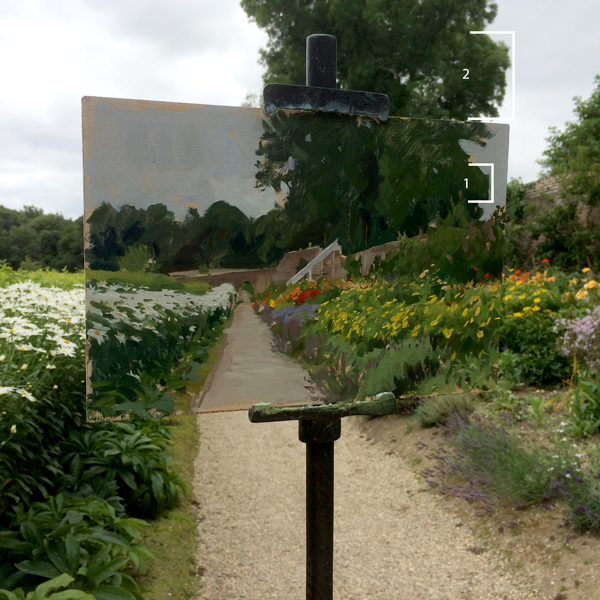
The first time I saw a plein air painting incorporated into the surrounding landscape in that way was many years ago when someone took a photo of a painting I was working on outside (above). This person lined up some of the major lines in the painting with the lines in nature behind the panel and thought it was very clever. At the time I was mildly annoyed with the image as I thought it would confuse people into thinking that it somehow related to sight-size.
As it turned out, I was right.
A few years later when we all started carrying decent quality cameras around in our telephones, I started regularly posting my paintings to social media directly from the field. Usually I took a photo of my painting with the actual scene on one side, so students who follow me could see my decisions by comparing the two. On a few occasions though, something would happen where my view would be obscured when I was finished and I would take the photo with the painting covering the scene. I would also align some of the lines so that the painting and the background appeared to merge.
One example of this is the painting below, where a tour group arrived and parked themselves in the path just behind my panel. As it was lunchtime, and I didn’t want to wait for them to leave, I used the painting to block them from the view.


This has nothing to do with sight-size though. In the photo above, you can see how the painted bulge of the tree (1) is completely different in size from the actual shape in nature (2). This is because, in order to get the lines to line up, I’ve had to pull the camera back away from the painting. When I did the painting my viewpoint would have been closer, and the two shapes would have been the same size. (See my sight-size video on YouTube for further clarification).

All I’ve really done is moved the camera until some of the major lines in my painting align with the same lines in the actual scene. I even had to tilt the camera away from the panel a bit to get it to work.
This has been a bit long-winded, but I just wanted to say that these aligned photos have nothing to do with sight-size. Any artist working outside can do them, with any technique or medium. Having compressed, naturalistic values will help with the illusion, but I’ve seen some wonderful examples of very stylized work doing the same trick. Just move the camera until a few important shapes line up with the view behind.
I’m glad you wrote this post Marc on your photographing style. I’ve never really liked the concept as I dont want to equate photography and painting on equal terms, but yours are convincing illusions. Since you have started doing your photo-painting-scene pictures I have seen countless other people attempt the same thing. The others dont really work as well.
Will this tutorial actually help them if they dont have skill in drawing and scale? I doubt it somehow.
Is there post-production of the photograph to make the hues and values in the painting section of the photo coordinate more closely with the hues and values of the nature section of the photo? I appreciate that, as a naturalistic painter, you are aiming for the painting to replicate the hues and values of nature. Even with the most accurate painting, though, I wonder whether a photo of that painting in its plein air setting would render painting and context in a way that makes them appear so seamless.
Thanks for clarifying that Marc. I had started to wonder if everyone was using sight size to paint outdoors due to all the aligned photos and paintings appearing online; now I know what’s going on.
Przepiękny obraz, zdjęcie wspaniałe!!!